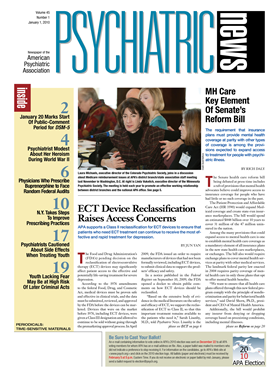The Senate health care reform bill being debated at press time includes a raft of provisions that mental health advocates believe could improve access to insurance coverage for people who have had little or no such coverage in the past.
The Patient Protection and Affordable Care Act (HR 3590) would expand Medicaid coverage and create state-run insurance marketplaces. The bill would spend an estimated $848 billion over 10 years to cover 31 million of the 47 million uninsured in the nation.
Among the many provisions that could expand access to mental health care is one to establish mental health care coverage as a mandatory element of all insurance plans in the new state health care marketplaces, or exchanges. The bill also would require exchange plans to cover mental health services at parity with other medical services. The landmark federal parity law enacted in 2008 requires parity coverage of mental health care in only those plans that opt to offer mental health benefits.
“We want to ensure that all health care plans offered through this new federal program comply with the principle of nondiscrimination and parity for behavioral health services,” said David Shern, Ph.D., president and CEO of Mental Health America.
Additionally, the bill would prohibit any insurer from denying or dropping coverage based on preexisting conditions, including mental illnesses.
Another provision important for mentally ill people is that the bill would greatly expand eligibility for Medicaid, which covers about a quarter of all mental health care provided nationally. The bill would expand eligibility for Medicaid in 2014 from only certain classes of people to all children, parents, and childless adults who are not eligible for Medicare and who have incomes up to 133 percent of the federal poverty level. States could begin to expand eligibility as early as January 1, 2011.
Other Medicaid changes would require states to include mental health parity in the model each creates of generally available private health care coverage that determines what coverage their Medicaid program will provide.
The bill also would fund Medicaid psychiatric demonstration projects to study innovative approaches to emergency psychiatric treatment and stabilization.
Further, the legislation would make mental health-related changes to Medicare. It would establish a series of demonstration projects, or pilot programs, of so-called medical homes, that would designate a single clinician to coordinate the care of patients with multiple chronic ailments. Efforts by mental health advocates resulted in a provision to include psychiatric illnesses among the medical conditions for which patients could receive care under a “medical-home” system in which all care is coordinated. The legislation also would include mental health care providers in the “health team” that treats people included in medical homes.
“It is critical that behavioral health specialists are included in the treatment teams established through these care models and also that mental health or addiction treatment facilities be allowed to serve as medical homes,” Shern said. “Mental health disorders are the leading cause of disability in the United States based on burden of disease, and these conditions often accompany and greatly increase the cost of treating other chronic illnesses, including diabetes, asthma, cancer, and heart disease.”
The legislation leaves unaddressed at least one major concern of physicians. As introduced, the Senate measure does not eliminate the 21 percent cut to physician payment rates scheduled to go into effect this month for Medicare. A $210 billion, 10-year measure to replace the cut with a small increase and replace the system used to determine clinician reimbursement rates was passed by the House of Representatives last November, but the Senate rejected such a stand-alone measure. However, advocates hope such a provision may be added during negotiations between the House and Senate to resolve differences between their respective health care reform measures.
The legislation also includes a provision to extend a mental health add-on in the Medicare physician fee schedule. It would increase the payment rate for psychiatric services by 5 percent for two years, or through the end of 2011.
The Patient Protection and Affordable Care Act can be accessed at <http://thomas.loc.gov> by searching on the bill number, HR 3590. 
